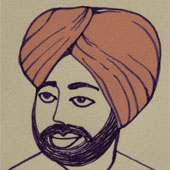In the Persian language the ‘Turban’ was pronounced as “Dulband”. Its origin is said to have come from ‘Dul’ or ‘Tul (pronounced by Arabs) or ‘Volvere’ which applies to head-wrap. From the Turks, it might have passed on as Tulipant, Tolliban, Turbant etc. in the European usage of Turban. “Turban” as a headdress became popular in the medieval era and the word ‘Turban’ came along during the 15-16 centuries. This head-dress is mostly referred to as ‘Pugree’ in different regions of India but pronounced differently.
It is commonly known as Dastar or Pag in Punjabi, Paghri in Hindi and Dastar or Paghri in Urdu. Chira, Safa, Siropa, Madhasa, Keski and Parna are the other terminologies in Punjabi which is used to refer to the different styles of head-dress prevalent in Punjab.
The word Pag is said to be originated from Puk in Hindi, which means white hair or grey hair signifying wisdom thus, Pag stands for prudence and sagacity.
The word Dastar is originally a Persian term, which means a head-dress tied up with the help of hands. Pag is generally a term used for a common man’s turban in Punjab, whereas, Dastar denotes the turban of an eminent or religious person. Hence, there is a sense of honour and gracility associated with the term Dastar.
Safa, comes from the Hindi word Safai, which means cleanliness. It is mostly seen in Punjabi households, where while working, men carry a 2.5-meter long and 1-meter wide cloth on their shoulders. They use it as a handkerchief to clean their face and hands. And many times while working they tie the same cloth on their head as a turban.
Siropa comes from the word Sir in Hindi, which means head and so Siropa denotes a cloth which can be tied on the head. It’s a symbol of honour, given to a person for doing outstanding work for the Sikh welfare.
Madhasa comes from the Punjabi word Mundi which means head. This style of turban used to be worn during wars to protect the head and neck from the opponent's attack.
It’s a heavy turban, which is tied very tightly on the head. Chira is used to denote a red turban, which is less wide and is usually worn during weddings.
Keski, comes from the Punjabi word Kes, which means Hair. The headdress used to cover the hair is known as Keski.

Source: ‘Pag ate Pag da Sabhiachar’ Book by Jagdev Singh Aulakh. Translated from the original in Punjabi.

